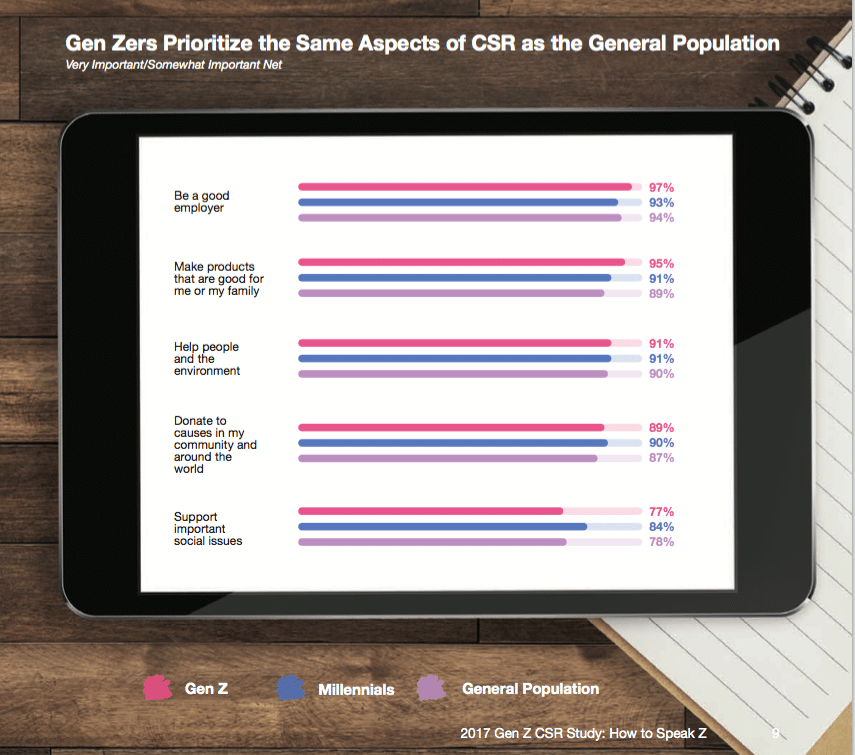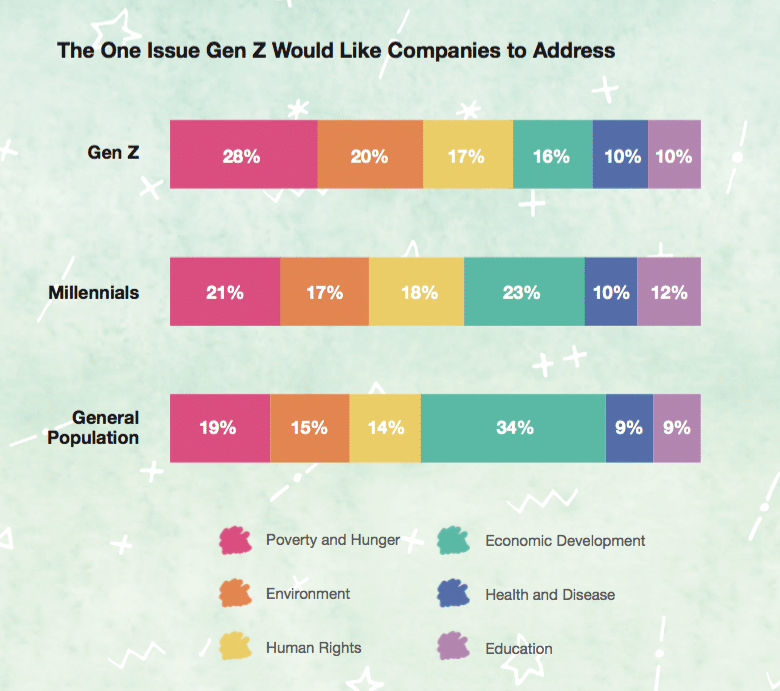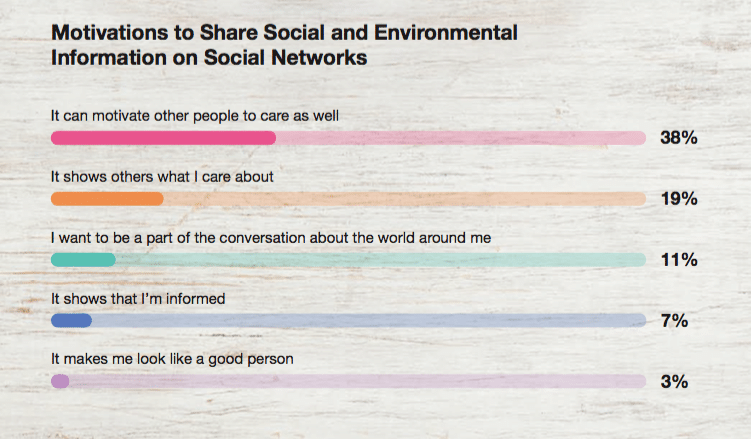New research from Cone Communications reveals the critical role social media plays in how the emerging and imminently powerful Generation Z wishesß to engage with companies around corporate social responsibility initiatives. The firm’s new study found that more than 4 in 5 (82 percent) use social media to talk about issues they care about—and a large majority (87 percent) are likely to share their positive opinion of companies addressing social and environmental issues.
The 2017 Cone Gen Z CSR Study: How to Speak Z, surveying Americans ages 13-19, examines this budding generation’s aptitude and attitudes toward company involvement in social and environmental issues—and just how they’re willing to stand up for causes they care about.
“Although Gen Z may be glued to their phones, don’t mistake that as a disregard for the pressing issues facing the world today,” said Alison DaSilva, executive vice president of Cone Communications, in a news release. “This generation is interested and engaged—and they’re looking to companies to help them create a movement of positive change.”
Socially conscious—from an early age
Brought up in an age of recycling programs and diversity education, Gen Zers are a highly-enlightened group. Ninety-two percent say they care about social and environmental issues—and they express concern for the future. Nearly nine-in-10 (89 percent) say they’re worried about the health of our planet. To solve for this, they see companies as critical solution providers, with 94 percent believing companies should help address critical issues.
Gen Z looks to its purchasing power as a critical way to support responsible companies. Nearly nine-in-10 (89 percent) say they would rather buy from a company addressing social or environmental issues over one that is not, and 92 percent would switch brands to one associated with a good cause, given similar price and quality—skewing just slightly higher than the national average (89 percent).
Still, this generation with a notoriously short attention span can’t be expected to seek out CSR messages. In fact, just shy of two-thirds (65 percent) said they pay attention to a company’s CSR efforts when deciding what to buy.
Keeping it positive: Engaging Gen Z in CSR efforts
Gen Z sees the power of positive reinforcement when it comes to supporting companies solving for important social or environmental issues. This group is likely to participate in a number of ways, but slightly less apt to take more confrontational actions in comparison to their older cohorts, like boycotting a company (76 percent vs. 90 percent Millennial, 88 percent general population) or protesting to help a cause (58 percent). Top actions include:
- Buy a product with a social or environmental benefit (90%)
- Volunteer for a cause (87 percent)
- Donate to a cause (85 percent)
- Sign petitions to help causes (84 percent)
- Share social or environmental information with social networks (77 percent)
- Boycott a company that is doing harm (76 percent)
- Protest to help a cause (58 percent)
“While close in age, there are vast differences between how Gen Z and Millennials prefer to engage with brands,” said Whitney Dailey, director of marketing/research and insights at Cone Communications, in the release. “Millennials are keen to boycott or engage in a frank dialogue with brands, but Gen Z prefers to have a less antagonistic relationship with brands. This generation is more likely to be an advocate than an adversary.”
Defining responsibility through the Gen Z lens
For a generation just edging toward adulthood, their definition of what it means to be a responsible company is more multi-faceted and sophisticated than one might expect—and their standards and expectations of companies are high. This generation believes responsibility is primarily about being a good employer (97 percent), while also making products that are good for individuals and their families (95 percent). Yet, more than three-quarters also believe companies should:
- Help people and the environment (91 percent)
- Donate to causes in local communities and around the world (89 percent)
- Support important social issues (77 percent)
Poverty and hunger priority issues for Gen Z
Differing from older cohorts, when asked specific issues companies should address, Gen Z was the only generation to prioritize poverty and hunger (28 percent vs. 19 percent general population) over economic development (16 percent vs. 34 percent general population). Other important issues include:
- Environment (20 percent)
- Human rights (17 percent)
- Health and disease (10 percent)
- Education (10 percent)
Beyond these broader issues, Gen Z also believes companies need to stand up for issues that are taking center stage in the media today. While job creation (96 percent) and reducing the high cost of college (92 percent) were top of mind for this generation, more than two-thirds look to companies to support a range of issues:
- Racial equality (88 percent)
- Women’s rights (86 percent)
- Immigration (81 percent)
- Climate change (81 percent)
- Gun control (68 percent)
- LGBTQ rights (65 percent)
“This always-on generation is consuming news and content at an almost instantaneous rate—so Gen Z is oftentimes the first to know of social injustices happening around the world,” said DaSilva. “This heightened awareness means they’re putting even more pressure on companies to step up and solve for these hot-button issues.”
Parents and friends most likely to influence
When purchasing a product with a social or environmental benefit, Gen Z is most likely to look to those closest to them for information. Parents (54 percent) and their close group of friends (44 percent) are most likely to influence purchasing decisions. And in line with the growing importance of social media in the lives of this generation, Gen Zers are also equally swayed by people on social media (26 percent) and the news (26 percent). Companies (17 percent) and celebrities (16 percent) fall to the bottom of the list of Gen Z’s trusted sources.
“Gen Z doesn’t want to feel like they’re being marketed to by a company,” said Dailey. “This group is looking to those closest to them for trusted information. And with their phones always by their sides, they consider social media as influential as news. Marketers will have to take a more personal, social-first approach to reach this new generation.”
Using social media as a tool for advocacy
Gen Z sees social media as a powerful tool to create change. In fact, more than half (58 percent) feel that supporting social or environmental issues online is actually more effective at making a difference than doing something out in their communities. In alignment with this feeling of individual empowerment, the top motivation to share online content related to CSR efforts is to motivate others to care as well (38 percent). This generation is less motivated by more self-interested actions like showing others what they care about (19 percent), wanting to be a part of the conversation about the world around them (11 percent), showing others they are informed (7 percent) or making them look like a good person (3 percent).
“This generation has seen the virality of social content and sincerely believes their online voices can be a source of inspiration and encouragement to get others involved,” said DaSilva. “Companies can tap into this sense of empowerment by giving Gen Zers the content and the tools to share CSR messages—whether that’s badges, short videos or sample posts.”
In keeping with their goal to do good and inspire others to do the same, Gen Z is most likely to turn to their smartphones to have a positive and empowering experience. Top actions for online engagement with companies around CSR efforts include sharing their positive opinion of a company addressing social or environmental issues (87 percent) or learning what they can do to make a difference (86 percent). In alignment with offline actions, this group is less likely to take more hands-on or contentious actions against companies, such as speaking out against a company (68 percent) or researching if a company is helping or hurting society or the environment (69 percent). Other online actions include:
- Voting to pick a charity to receive a donation (86 percent)
- Watching a video about a social or environmental issue (83 percent)
- “Liking” or following a nonprofit or company’s CSR program (79 percent)
- Giving feedback directly to companies about their CSR efforts (70 percent)
Although this generation may the first to adopt new social networks, when it comes to engaging with social and environmental issues online, Facebook (66 percent) still tops the list. However, half turn to additional channels such as Instagram (51 percent) and YouTube (50 percent) to advocate and learn about important topics, and more than a third use Snapchat (43 percent) and Twitter (35 percent). In terms of the content Gen Z prefers to engage with, highly visual and compelling content is most likely to resonate. Preferred types of online content include:
- Videos (68 percent)
- Pictures (56 percent)
- Written articles or stories (49 percent)
- Infographics or data (33 percent)
“When the attention span of a Gen Zer can be as short as the loading time on a website, it’s critical companies reach this generation with content that’s going to grab—and keep—their interest,” said Dailey. “Targeting this generation on just one channel is not going to cut it. Your content must be on multiple platforms and as diverse and engaging as possible.”
The 2017 Cone Gen Z CSR Study: How to Speak Z presents the findings of an online survey conducted March 9–15, 2017 by M/A/R/C Research among a random sample of 1,003 Americans, comprising 500 males and 503 females, ages 13-19. The margin of error associated with a sample of this size is ± 3% at a 95% level of confidence.











